Brockton Fair

Planned racing at the Brockton Fair has been pushed back to August:
The property owner and the association both said that more time was needed to budget for administrative costs and to fix the inner rail of the track, which was damaged by a vandal last year who stole about 1,000 feet of the metal barrier to sell for scrap.
“We would have hoped to start a little bit sooner,†said Bill Lagorio, president of the Massachusetts Thoroughbred Horsemen’s Association. “We are hoping, with all things considered now, we’ll race in August, September and October. … We don’t mind going a little further into the fall because it’s nice racing weather anyway.â€
If a meet at Brockton happens this year, training and racing will take place over four months on the five-furlong dirt track. Lagorio addressed safety concerns raised by observers about that plan:
Lagorio also responded to criticism of the track, which he said is mostly being leveled by a rival horse racing association that is participating in the six races at Suffolk Downs this year. Lagorio said that some people unfairly point to the injury of one horse when racing last took place at the Brockton Fairgrounds in 2001, but he said the sport inherently has its risks.
“There’s nothing not safe about Brockton,†Lagorio said.
Count me among the worried, and not because of anything that happened 15 years ago. Thanks to greater attention on safety issues, ongoing research, and the Equine Injury Database, we now know more about track surfaces, injuries, and risks than we did a decade ago. We know that dirt tracks consistently register more fatalities than turf or synthetic tracks, averaging 2.07 fatalities per 1000 starts from 2009-2014, compared to 1.65 for turf and 1.22 for synthetics. Over the same six years, races at distances less than six furlongs averaged 2.25 fatalities per 1000 starts, compared to 1.82 for races six to eight furlongs, and 1.74 for races longer than eight furlongs.
The work of Dr. Mick Peterson has yielded clues into how track maintenance and moisture content affects safety. Dr. Tim Parkin, studying the EID, has identified factors that may make a horse more vulnerable to fatal injury, including past injury, time between starts, drops in claiming price, and age.
For what Dr. Parkin’s work means in practice when it comes to a vulnerable horse population, read Dr. Jennifer Durenberger’s Thoroughbred Racing Commentary piece about reducing the fatality rate at Suffolk Downs in 2014:
Let’s look first at the catastrophic injury rate for the meet: 1.24 per thousand starts. This is down from 1.73 in 2013 — a nearly 30 percent reduction. While I maintain that this particular metric tells only a small part of a much bigger story about the job we do protecting the overall safety and welfare of our equine athletes, it’s still the easiest number for us as an industry to obtain and compare across jurisdictions — both major league and minor league. Thanks to the Jockey Club’s Equine Injury Database (EID), which captures data from an amazing 93 percent of all flat racing days, we know that the average catastrophic injury rate in 2013 was 1.9 per thousand starts. That includes all horses – young and old, graded stakes competitors and seasoned claimers, sprinters and routers, turf specialists and mudders. When we separate that by surface, we see a nationwide average of 1.63 catastrophic injuries per thousand turf starters and 2.08 per thousand dirt starters. At Suffolk Downs in 2014, the turf rate was 1.44 and the dirt rate was 1.20 – less than 60 percent of the national average.
Thanks to some of Dr. Tim Parkin’s comprehensive epidemiological analysis of five years of EID data, we know that there are certain risk factors associated with catastrophic injury. Nine have been identified with statistical significance, including older horses, horses making “numerous starts within the past 1-6 months,†and horses entered in claiming races for a tag less than $25,000. It’s no secret that the vast majority of horses competing at Suffolk Downs fit squarely within this profile. For years, Suffolk has welcomed equine athletes in the later stages of their careers and helped transition them once the race was over. Our catastrophic injury rate was achieved amongst a population of some of the highest-risk horses in the country — competing for some of the lowest purses in the country.
High-risk horses competing for small purses — that’ll be racing at Brockton.
And those horses will be training and racing on a bullring that’s five furlongs with a chute. Last month, at the Grayson-Jockey Club Welfare and Safety of the Racehorse Summit, Dr. Peterson addressed an issue that should interest anyone considering running at Brockton — what are the musculoskeletal effects of turning? You can watch the archived video of his presentation — it’s less than 20 minutes long, and begins at approximately 1:12. The upshot — turning is stressful, and more so on dirt surfaces, due to their variability. He raises a provocative question — “Do traction limited horses [as those running on dirt may be] have a certain number of allowable turning strides?”
The causes of racing injuries are complex, and safety can never be absolute — but the conditions that horses will be asked to race under at Brockton, and the kind of horses who will be entered to race, are higher risk.
One last thing — Brockton, as a condition of the racing license approved by the Massachusetts Gaming Commission last fall, only has to make a good faith effort to earn NTRA Safety Alliance accreditation.
Horses first, says the Massachusetts racing office. For all involved, racing at Brockton will put that motto to the test.
7/19/16 Update: The Brockton request for Race Horse Development Fund money for purses is back on the agenda for the July 21 MGC meeting.
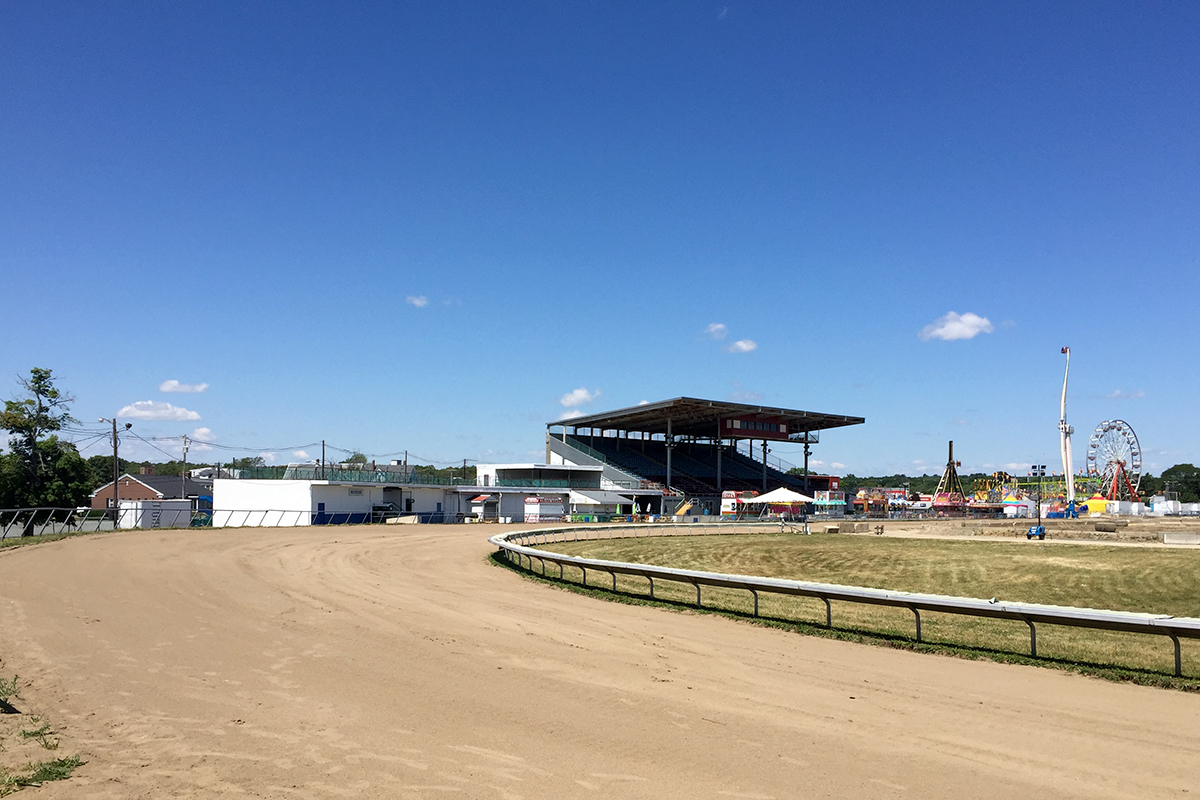
Construction began at Brockton Fair several weeks ago to restore the racetrack for a planned Thoroughbred racing meet there this year, the first since 2001. Extensive work is required — it includes rebuilding the track surface and installing a new rail — and days for the meet have yet to be set. What was projected in May as a July 2 start was bumped back to mid-July and now, late July, while a request for up to $150,000 a day in purse money from the Race Horse Development Fund was dropped from the Massachusetts Gaming Commission’s June 23 meeting, to be rescheduled on a date to be determined.
“I couldn’t get it all together in time. There was just so much crammed in,” Chris Carney, whose family owns the fair property, told Lynne Snierson:
“I’m still working on the track, doing the rail, and taking care of a lot of other things.”
Carney said he plans to go back to the MGC in the middle of July in the hope of starting the meet July 30, but will have a better idea of how many race-ready horses remain in the area after Suffolk Downs starts the first of its one weekend per month, six-day 2016 meet the weekend of July 9-10. Suffolk will not race again until the weekend of Aug. 6-7.
“This is a minor setback,” Carney said. “If the rail from before hadn’t been stolen and I had a safety rail in place, I wouldn’t have a problem now. I have barns already set up for 150 horses and I’m working on the other barns. It’s just a matter of time.”
According to a Massachusetts Thoroughbred Horsemen Association Facebook post from June 24, the track will open for training when the new rail is up:
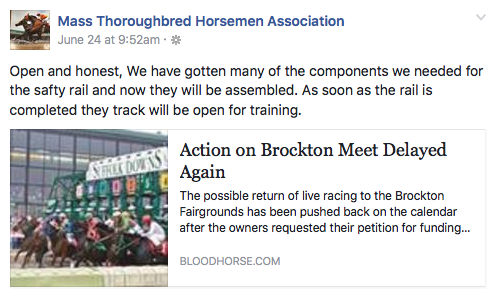
Brockton is a five furlong track, wide enough for a maximum of eight horses in each race. Stall applications are open, via the MTHA’s website. A condition book — like the racing calendar — has not been released.
I visited the grounds on July 3 to see the track restoration in progress.
Photo of the grandstand from the first turn:

(Flashback: Horses racing on the clubhouse turn in 2001.)
View from the turn onto the backstretch:
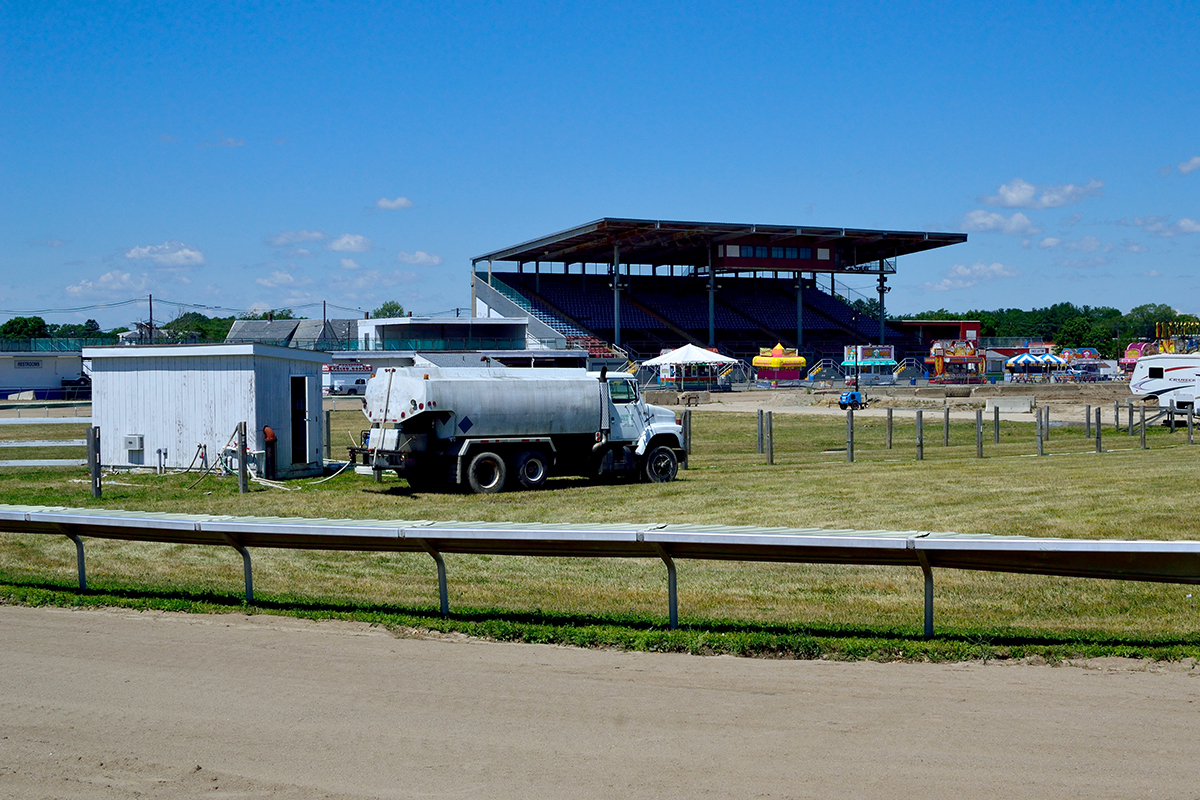
And the view down the backstretch:
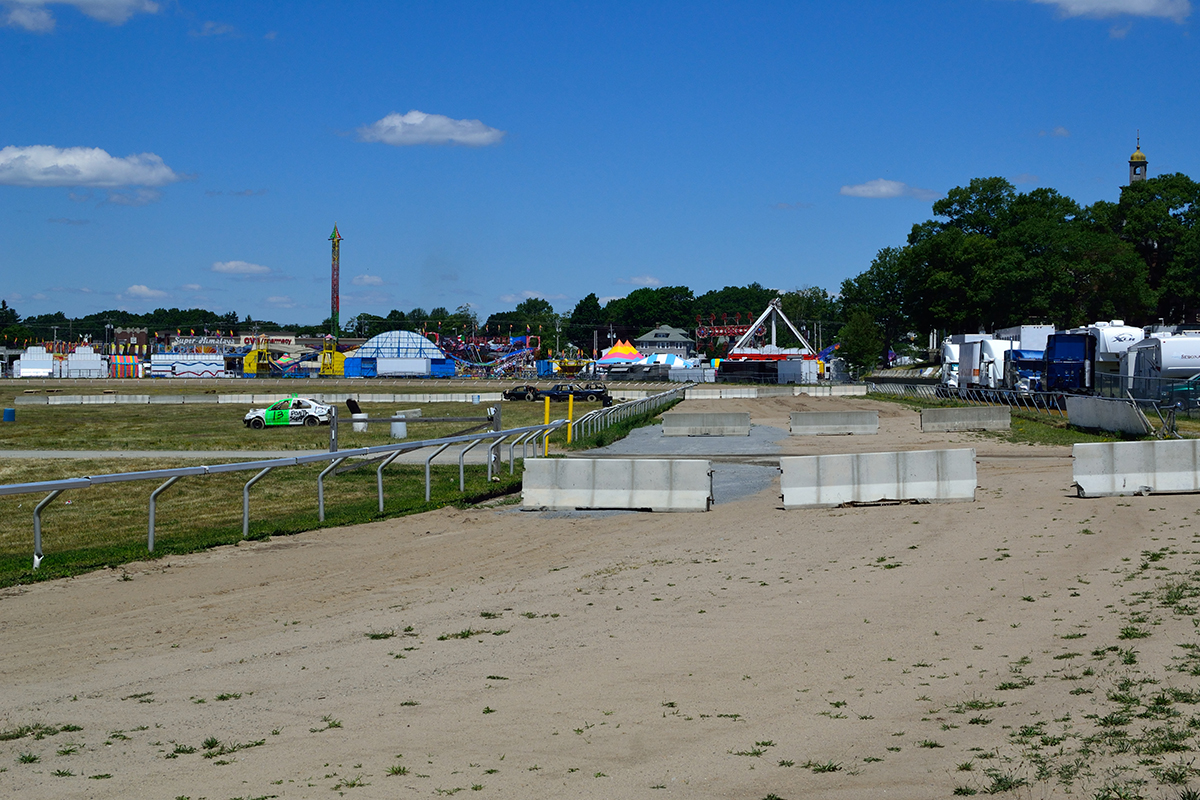
You can see that much of both rails are in place, with some bits to fix:
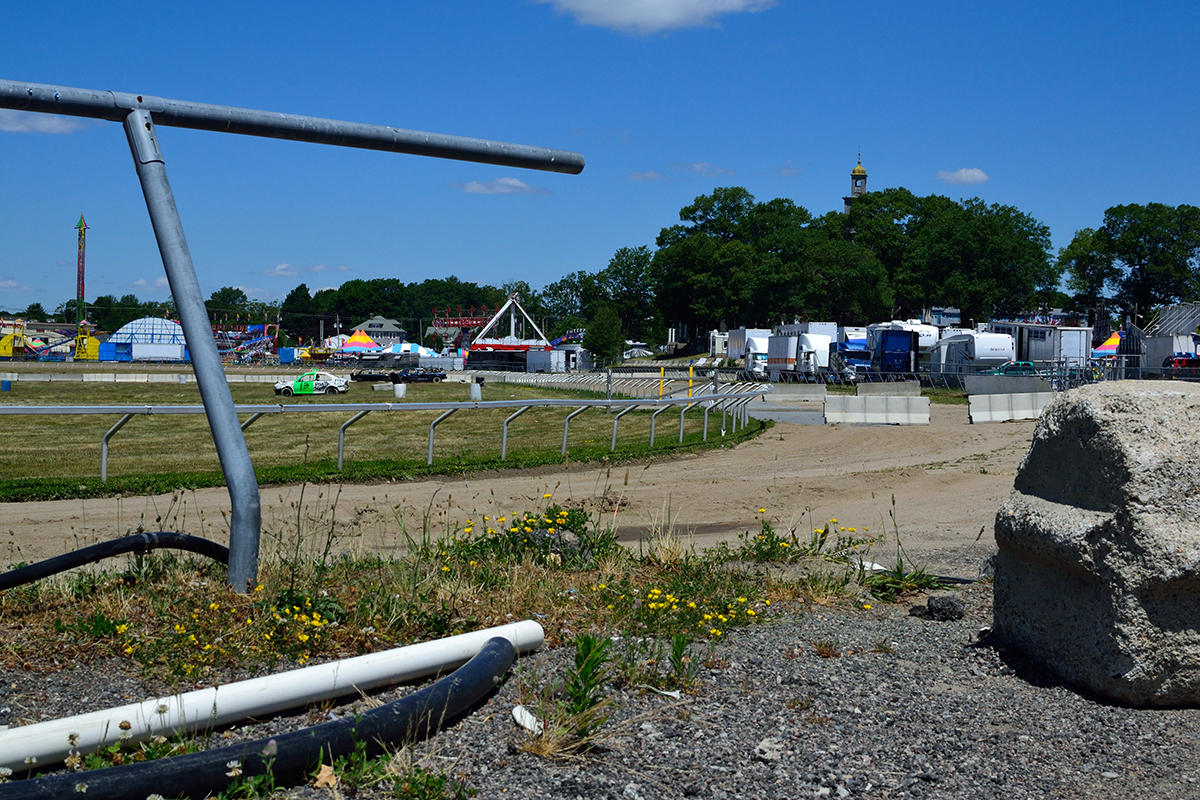
The paddock, looking toward the barns:

Piles of wood in place for the barn refurbishment that’s underway:
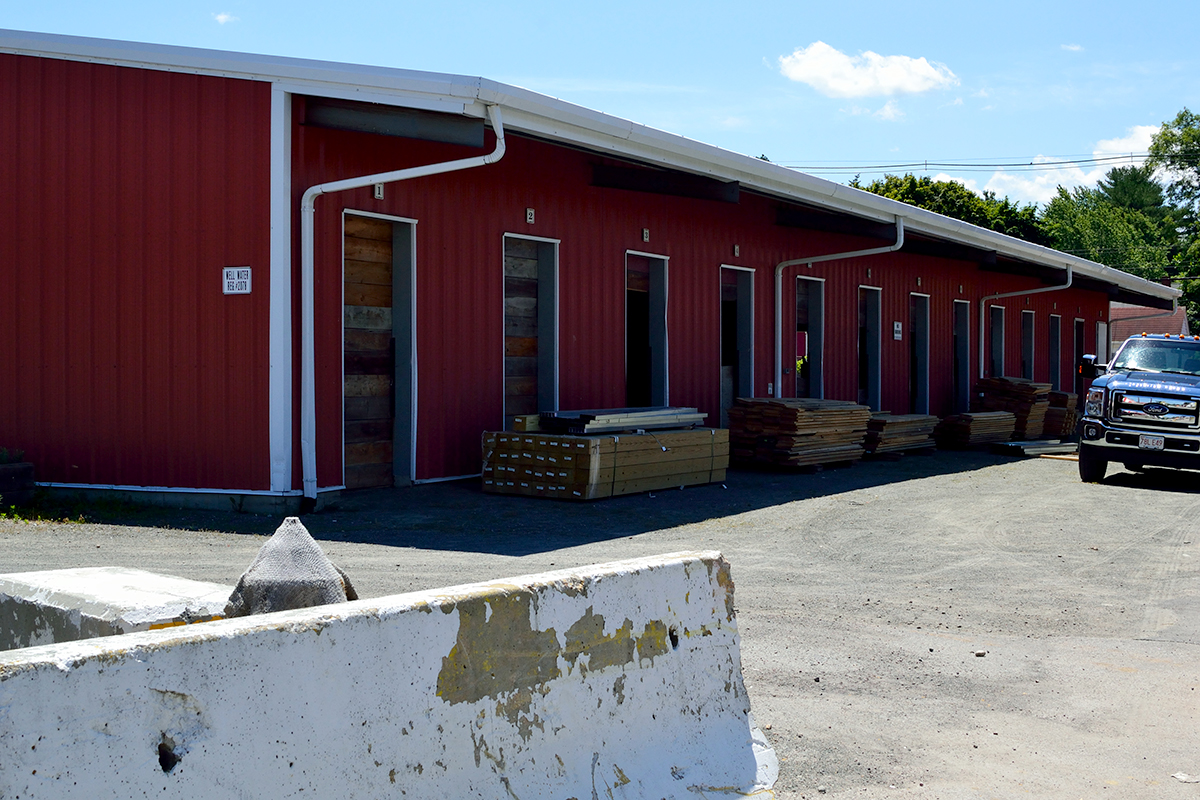
Penn National, George Carney, and as-yet-unidentified revenue streams. If you follow horse racing — if you follow Massachusetts racing — it sounds like the set-up to a bad joke, doesn’t it? But those are the options for continuing Thoroughbred racing in the state that the Massachusetts Gaming Commission will discuss at a meeting next Thursday. “Empty posturing,” said Suffolk Downs COO Chip Tuttle, who gave notice of layoffs to the state Labor department and 176 track workers on Wednesday.
The Commission apparently plans to ask Penn National about the possibility of a Thoroughbred meet. “It’s something we have not looked at,” VP of racing Christopher McErlean told Lynne Snierson, “but in the future, who knows?” The company is currently constructing a slots parlor at Plainridge; its renovations at the harness track don’t include a dirt or turf course.
Carney, and his son Christopher, owners of the Brockton Fairgrounds and the defunct dog racing track Raynham Park, are planning to request 2015 dates for their five-furlong dirt fairground course, which hasn’t been used since 2001. “It might not be big, glitzy, and glamorous, but it worked for us,” said Christopher Carney, extolling the virtues of a bullring track to Snierson:
Carney reasoned that since the dirt track is six furlongs and there is no turf course, out-of-town outfits would not ship in to compete against locals, as they have done at Suffolk Downs.
That sounds like a great racing product, just what the bettors love. Why such racing would appeal to some horsemen — and why, in the short-term, it might even be desirable as a source of jobs — is understandable, but there’s no shot that kind of racing survives long-term, and not only because it would attract so little attention and handle. Before the expanded gaming legislation passed, there were state legislators clamoring to reduce or eliminate the monies going into the Race Horse Development Fund so that it could be used for local or school aid. The subject hasn’t come up lately, partly because there hasn’t been any money, other than the Plainridge license fee, but mostly, because the state economy and budget aren’t stressed. When there’s a slump or shortfall, the RHDF will become a target. Purses or textbooks? It’ll be an easy choice.
That Penn or Carney are what’s on the table is depressing. Racing at Suffolk might not have been the best, but track management didn’t neglect safety or aftercare issues, and the work they were doing with the state Racing Division in building a regulatory framework that relied on uniform rules and putting horse welfare first hinted at the quality of racing that could have been, even if average daily purses (with the RHDF money) still didn’t reach the top tier.
Two links to leave with —
Jen Montfort stands up for Suffolk Downs:
Yes, it looks like parts of it haven’t been updated since the 50s, and you could probably stage an Olympic event based on navigating the undulating concrete floor. But they very well could’ve completely let the place go these past years, and they didn’t. It’s clean. The paint isn’t peeling. For a plant that is over 75 years old it’s in pretty good condition. The landscaping is actually quite lovely. And in the summer there is absolutely no better place to sit in the stands to watch some racing, enjoy a breeze off the ocean, and see that lovely infield and the marsh and Atlantic Ocean beyond.
There was absolutely nothing pretentious about Suffolk Downs or the people who called it home. There were the old war horses like Rise Jim, Let Burn, Darby Gillic and jockeys who rode not for the glory but to put food on the table, guys named Carl Gambardella, Rudy Baez, Jack Penney, Vernon Bush. Saratoga was classier. Santa Anita was prettier. Churchill had the Kentucky Derby. No one at Suffolk Downs cared. Jealousy wasn’t part of their fabric …
It was a beauty-is-in-the-eye-of-the-beholder type of love affair that a lot of us had with Suffolk Downs but the place really was special, in its own unique, unapologetic, Boston working class way.
It really was. (Is, for five more racing days.)
Copyright © 2000-2023 by Jessica Chapel. All rights reserved.